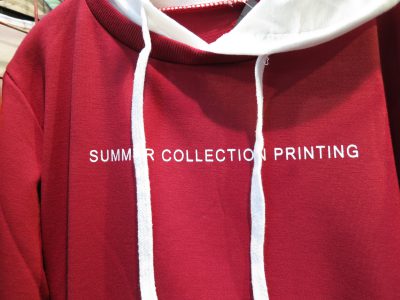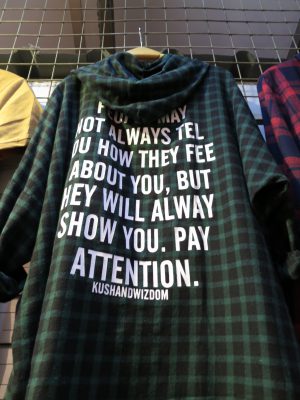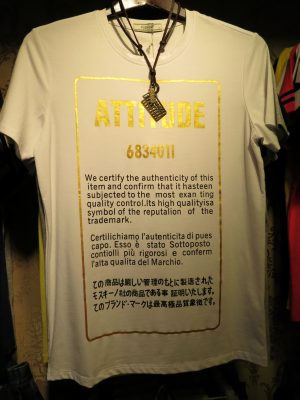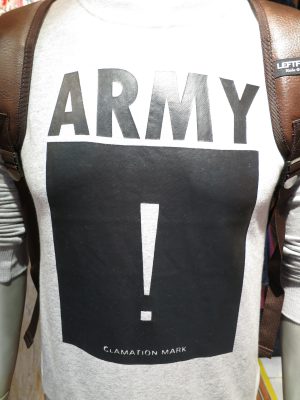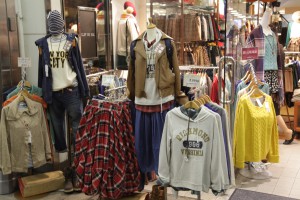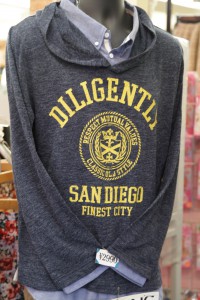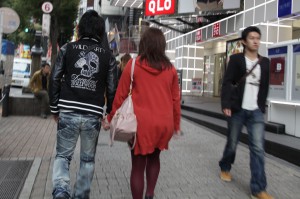The following items are available for sale locally.
Tag Archives: manglish
Seen on a Thermos in Matsumoto
Manglish
English is widely used in Japan. It is in Korea too, but not to anywhere near the same extent. It’s in business names, book titles, and other places that don’t seem to be aimed at foreigners. French also shows up more than I expected, and French bakeries are de rigueur. There’s even some occasional Italian. But mostly it’s English.
In both Korea and Japan I’ve seen a lot of shirts purporting to be from places in the US, usually done in a collegiate style. And you don’t have to travel abroad to get them.
Almost all of them are from places in the US, but they can be from other places too, as long as you have that look.
A shirt might look authentic until you read it.
But Japan also has bizarre sayings, something I did not see in Korea. As I was going through passport control in Fukuoka, I saw a Japanese girl with a shirt that said, “Sweet Holic the Most.” I’ve seen plenty of others since then.
Some are semi-understandable.
Some are not.
Some have a simple message.
Some have mustaches.
And some take things to another level entirely.
Notes on Korea
Sometime in the last 25 years, hanja seems to have disappeared. That makes Korean a lot easier to read for us non-Asian types who didn’t spend 12 years learning Chinese characters in school.
You won’t get mugged in Korea, but you might get run over. It’s the only place I’ve seen someone talking on the phone while riding a motor scooter. On the sidewalk.
Korean people don’t seem given to wearing shirts with bizarre English on them the way Japanese people are, but almost every shirt I saw with writing on it was in English, usually an American brand of some sort. I think some of them were fake brands (one shirt simply said “Authentic Genuine”), but they looked like American brands. That seemed to be the main thing.
Passport control was just a matter of taking fingerprints and a photo (Japan did that too) and stamping my passport. Customs just took my form and put it on a pile without looking at it. I think it was the easiest entry I’ve ever encountered.
Other than the traditional hanok-style buildings with the sweeping roofs, there isn’t a lot of what you would call architecture in Korea. On the train from Seoul to Busan, the cities I saw were all miles of high-rise apartment buildings done in what you might call a Soviet style, with a smattering of Christian church steeples.
Everyone in Korea is doing something on their smartphone at all times. It goes far beyond anything in the US. Not surprisingly, most of the phones are Samsung or LG.
In Busan I saw a man wearing a shirt that said, “The Funniest Man in the World.” So that’s where he lives. Busan.
A Resting Place
Coffine Gurunaru informs me:
Coffine Gurunaru wants to be a tree and a ferry in a river just like a place to rest. A good quality of coffee and the health benefits of wine will definitely make your body and your mind upgraded and even your pride in your life. Please take a deserved break at Coffine Gurunaru. Coffine Gurunaru is a resting place for you.
But I just got some espresso to go. I had to be at the USO by 7:00 AM for the DMZ tour.
Lunch in Insadong
I had lunch in an area near the palace called Insadong. It was a little place called Gimgane, which sounded really promising.
Everyday special taste!
Only the fresh and stringent materials are used to have some representative menus of “Gimgane” with great taste and nutrition. Gimgane tries to provide the best tasting foods for the customers with the corporate philosophy of Faith, Honesty and Love.
I had pulgogi, which was not the best I’ve had. In fact, I don’t think I’ve ever not had better pulgogi. It was inexpensive, but they shortchanged me, so it was not as inexpensive as it could have been.
For dinner I had galbi at an excellent place not far from Bong House. Steak grilled at the table and a bunch of side dishes. A much better culinary experience.

